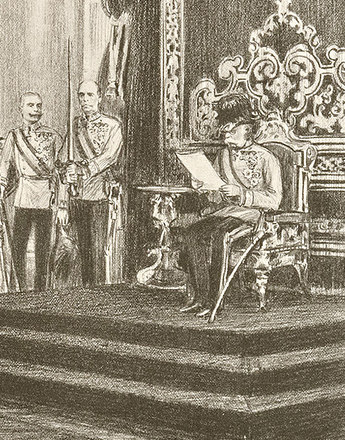
Victor Adler, photo around 1910
Copyright: ÖNB Bildarchiv
Partner: Austrian National Library
As early as 1848, the first harbingers of a labour movement appeared, a movement that played a significant role in the – if only short-term – successes of the middle-class revolution. Its political objectives corresponded over large areas with those of the liberal middle class, which likewise demanded political participation and fought against the neo-absolutist system, censorship and feudalism.
Alongside the demand for political equality, the labour movement advocated amongst other things the creation of educational centres for workers and the establishment of health and disability insurance funds. However, in contrast to the liberals it did not pursue a hierarchically structured model of society, and demanded universal suffrage, which ultimately led to the breach with the middle classes and their representatives.
After freedom of association and assembly were granted in 1867, worker education associations developed in Vienna and other cities of the Austrian half of the Empire – often with the help of the liberals – including the Erste Allgemeine Wiener Arbeiterbildungsverein. The course of the Industrial Revolution and the rapid growth of the urban proletariat that accompanied it plunged the working classes into poverty, and it was its inhuman living conditions that the labour movement attempted to improve. The ideological discussions were determined by two approaches that proposed different answers to the social question. The "state aiders", following Ferdinand Lassalle, argued in favour of an extension of the suffrage and the involvement of the workers in state affairs, in return for help from the state. The "self aiders", on the other hand, believed that the workers could become the equals of the middle class through education.
From the late 1860s, the labour movement had successfully extended its political activities by founding more worker education associations. It demonstrated for the right of association, for the freedom to found political associations and trade unions – which was finally granted in 1870. However, its increasing success gave rise to distrust on the part of the authorities, and for this reason the worker education associations were dissolved in July 1870 and the leaders of the labour movement accused of high treason.
The labour movement was however by no means a unitary political movement and instead was made up of groupings with different, in part competing, ideologies. While the "radicals" followed Karl Marx and Friedrich Engels and advocated the proletarian revolution, the "moderates" argued that the classless society could also be achieved by means of social reforms and the involvement of the working classes in government.
Despite the ideological disagreements, the Social Democratic Workers' Party of Austria was founded in Neudörfl in Burgenland on 4 April 1874, but remained divided into a moderate and a radical group. Although the German and Czech labour movements were amalgamated in 1877, which was seen as a huge success, the unification of the two wings of the Social Democrats was to take another eleven years. However, as the persecution of its radical and anarchist members by the authorities continued to increase, it was gradually realised that it was necessary to overcome the inner-party controversies. Finally, Victor Adler succeeded in unifying the ideological movements within the social democratic movement at the Hainfeld party conference in 1888/89.
Translation: David Wright
Buchmann, Bertrand Michael: Kaisertum und Doppelmonarchie, Wien 2003
Berchtold, Klaus: Österreichische Parteiprogramme 1868-1966, Wien 1967
Konrad, Helmut: Arbeiterbewegung und Sozialismus in Cisleithanien, in: Erdödy, Gábor (Hrsg.): Das Parteienwesen Österreich-Ungarns, Budapest 1987, 95-124
Kořalka, Jiří: Die Anfänge der politischen Bewegungen und Parteien in der Revolution 1848/1849, in: Rumpler, Helmut/Urbanitsch, Peter (Hrsg.): Die Habsburgermonarchie 1848-1918. Bd. VIII. Politische Öffentlichkeit und Zivilgesellschaft. 1. Teilband. Vereine, Parteien und Interessenverbände als Träger der politischen Partizipation, Wien 2006, 113-143
Rumpler, Helmut: Österreichische Geschichte 1804-1914. Eine Chance für Mitteleuropa. Bürgerliche Emanzipation und Staatsverfall in der Habsburgermonarchie, Wien 1997
Vocelka, Karl: Karikaturen und Karikaturen zum Zeitalter Kaiser Franz Josephs, Wien/München 1986
Vocelka, Karl: Geschichte Österreichs. Kultur – Gesellschaft – Politik, 3. Auflage, Graz/Wien/Köln 2002
-
Chapters
- Preconditions and beginnings of political participation
- On the road to political participation
- Liberalism and conservatism
- The rise and fall of liberalism
- Workers unite!
- Party of the masses
- Between a truce policy and left-wing radicalism
- Karl Lueger and the "Sausage Pot Party"
- "The Colossus of Vienna"
- Rise and fall
- Commitment to the Monarchy
- "Greater German", "Smaller German" or "German National"?
- "German and loyal, outright and true"
- "Prussian plestilence" or Habsburgophilia
- The battle for the 'national electorate'





